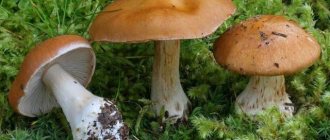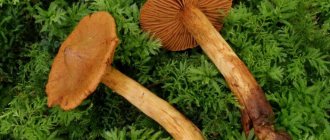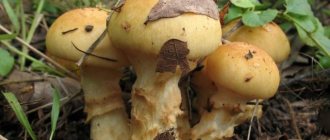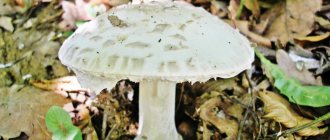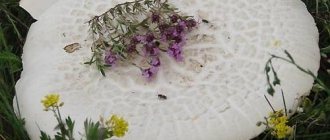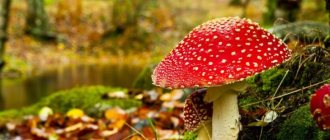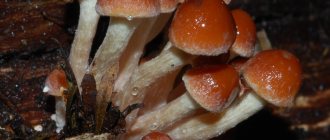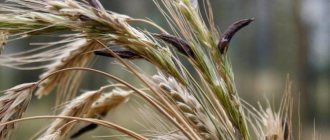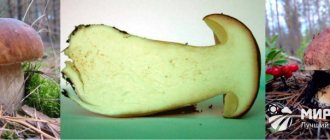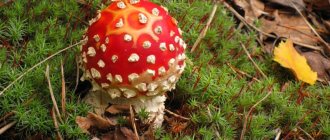In the wild, there are many types of different mushrooms, including edible and inedible specimens. Therefore, when going to harvest forest crops in the fall, you should be especially careful when cutting off little-studied fruiting bodies.
But plush cobwebs should be avoided altogether, since they are quite similar to some of their “brothers”, but are very dangerous.
Their toxins cause kidney failure, which over time can even cause death.
Both beginners and experienced lovers of quiet hunting should familiarize themselves with a detailed description of these representatives of the species.
Description
This genus has earned the name "spiderworts" due to the web-like remains of velum under the cap in the form of thread-like fragments. And the species in question is called plush because of the velvety, even slightly rough, surface of the cap and legs to the touch.
hat
Plush web spider.
The caps of the plush cobwebs are small, neat, up to 8 cm in diameter. Shape – from hemispherical (at a young age) to flat (at a mature state).
Color – golden (shades – from orange to reddish-brown). The surface is rough due to multiple scales and remains dry in any weather conditions.
Leg
The leg of the plush cobweb has medium dimensions: up to 9 cm long and up to 2 cm thick. It has the shape of a cylinder with a narrowing downwards. The surface is fibrous-rough. The color is usually pale yellow.
Mountain gossamer.
Spore-bearing layer
The spore layer consists of plates that adhere to the stalk. At first the plates are dark carrot-colored, but over time they darken and acquire the color of rust. They are located quite rarely.
Pulp
Like most members of the genus, the plush web spider has dense, pale yellow flesh. It emits a faint radish smell.
Spore powder
The spores are large, ovoid, with a tuberous surface. The mass has a rust color.
Harm and dangerous properties
Some species of spider webs are very toxic and poisonous [5]. They are most dangerous because signs of poisoning may appear after several days or even weeks, since they contain delayed-acting toxins. Their venom is very harmful to the kidneys and can cause a disease such as acute interstitial nephritis [6][7]. Even irreversible changes in the structure of the kidneys and death are possible [8]. According to statistics, for every seven cases of poisoning, one is fatal.
Characteristic signs of spiderweb poisoning are burning and dry mouth, severe thirst followed by vomiting, nausea, and abdominal cramps. The condition is often accompanied by headache and pain in the lumbar region. Even if you notice the symptoms in time and consult a doctor, recovery and treatment will take quite a long time.
In order to protect yourself, it is important to remember the first rule of a mushroom picker: if there are doubts about the edibility or inedibility of a mushroom, then it is generally accepted that it is obviously poisonous. In general, it is better not to take risks and entrust the collection of cobwebs to specialists who can confidently distinguish a good mushroom from its poisonous counterpart.
By the way, when preparing good edible mushrooms, it is worth remembering that violations in technology and non-compliance with processing rules can also lead to severe poisoning and sad consequences.
Providing first aid for poisoning
Any type of poisoning requires immediate medical attention before the ambulance arrives [9]. It is advisable not to transport the patient to the clinic, since some toxins can cause disruption of the cardiovascular system.
Before the doctor arrives, you should:
- put the patient to bed;
- perform repeated gastric lavage;
- give a laxative to drink to remove poison from the intestines;
- do a cleansing enema.
In case of poisoning, severe dehydration of the body occurs, so it is recommended to give the patient water with saline solutions, for example, rehydron, and give the victim cool, strong teas or salted water. For calf cramps, which often occur precisely because of dehydration, you can put mustard plasters on your shin.
If everything was done correctly and the danger was noticed at an early stage, then after such measures the victim may already feel an improvement in his condition within 2-3 hours.
However, this is not a reason to refuse hospitalization if recommended by a doctor.
Spreading
Cobweb is orange-red.
The distribution area of the plush web spider is some southern European territories. It has not yet been found in Russia. Prefers warm climates and acidic soils. Rarely found in coniferous forests, more often in deciduous forest belts. Carries out mycorrhiza formation mainly with birch or oak.
It grows mainly in early autumn.
Growing area
You can meet the most beautiful spider web in many forests in Europe. In Russia, it can be found in the central and northern regions. Grows in humid climates on acidic soils. As an environment, it prefers swampy lowlands and coniferous forests. Forms mycorrhiza with coniferous trees. Most often found alone or in groups of no more than 5 mushrooms. The fruiting period lasts from late spring to early autumn.
Similar species
The plush cobweb is similar to all other cobwebs of the genus Dermocybe.
Here are some of its representatives:
1-The cobweb is anomalous. 2-Spider web is dark red.
- The cobweb is anomalous.
- Cobweb is dark red.
- Bataille's cobweb.
- Cobweb carmine red.
- Cobweb is brown-yellow.
- Cinnamon cobweb.
- Saffron cobweb.
- Sultry cobweb.
1-Spiderweb carmine red. 2-Cinnamon cobweb.
- Huronian spiderwort.
- Spider web is saffron-brown.
- The cobweb is olive-brown.
- Purple cobweb.
- Polar web spider.
- Cobweb is reddish.
- Cobweb is blood red.
- Cobweb is reddish-platelike.
1-Spider web is saffron-brown. 2-Spider web purple.
- Sommerfelt's web.
- Tubariform cobweb.
- Marsh cobweb.
Yellow cobweb.
All of these spider webs are poisonous. But they are not very different from each other. For example, the most beautiful cobweb (reddish) differs from the plush one in having more reddish plates and the presence of a ring-shaped growth on the leg. All these species are difficult to distinguish even for an experienced collector.
At the same time, there are even edible species that are similar to the plush cobweb, for example, the yellow cobweb (although some sources classify it as inedible). It is salted or dried after prolonged digestion. But, since it is very similar to poisonous varieties, it is also not worth collecting without full confidence in its safety.
Application
In addition to traditional treatment, cobwebs are used in official medicine and cooking. The pulp of mushrooms is often compared in taste to porcini mushrooms, although the structure is slightly different - it is denser, tougher and does not change even with heat treatment.
Medicine
Most spider web mushrooms contain a high percentage of alkaloids. These elements are actively used in the manufacture of drugs against Alzheimer's disease.
Due to its antibacterial properties, spiderwort is used in medicine to make one of the antibiotics, inolomine. A blue dye is extracted from purple varieties of mushrooms, which is used to color some medications.
They use cobwebs in cooking to prepare tasty and healthy dishes.
Cooking. Cooking recipes
The basic rule for preparing cobwebs is that the mushrooms must first be boiled. Be sure to drain the water several times during the process, boiling for about a quarter of an hour each time.
The best gossamer dishes:
- Roast. Mix pieces of boiled mushrooms with slices of chicken fillet, onions, carrots and potatoes (cut into small cubes). Season with spices and vegetable oil. Place in portioned pots and bake in the oven. You can sprinkle generously with cheese crumbles a few minutes before it’s ready.
- Soup. To ensure that the first dish has a rich mushroom taste and aroma, you can prepare a broth from dry mushrooms (butter or porcini) in advance. Boil pieces of potatoes, carrots, add cobwebs (cut mushrooms into slices, boil). Season with vegetables stewed in vegetable oil - red pepper, onion and carrots. Sprinkle with herbs if desired.
- Stuffed mushrooms. Carefully separate the caps from the legs and boil them. Place the caps in one layer on a greased baking sheet. Chop the legs, mix with herbs, minced meat, and spices. Stuff the caps and sprinkle with cheese. Bake for about half an hour.
Do not store spider web dishes for more than two days. Even in the refrigerator they will begin to deteriorate; consuming a low-quality product can result in serious poisoning.
If favorable conditions are created, mushrooms can be grown independently
Interesting Facts
Dermocybe orellana.
- The plush web spider is known for its deadly poisonousness. Orellanin contained in this mushroom causes kidney failure due to irreversible pathological changes in the kidneys. Manifestations become noticeable approximately 2 weeks after poisoning (but may be earlier).
- By the way, the overwhelming majority of representatives of the spider web genus were considered harmless until the 60s of the last century. In total, more than 400 species of spider webs grow in European countries alone, some of them were considered simply tasteless (bitter), all the rest were considered quite edible.
- The plush cobweb was one of the edible and tasty mushrooms (since it does not have a bitter taste). However, due to mass poisonings with this mushroom in Poland, it was no longer considered edible.
Fried spider web recipe
For preparation you will need:
- edible or conditionally edible spider webs – 500 grams;
- flour - 4 tablespoons;
- vegetable oil – 3 tablespoons;
- greenery.
First, fresh mushrooms need to be thoroughly boiled, changing the water several times. Then cut them into small pieces. Place in a preheated frying pan and fry until almost done. Then pour flour into the mushrooms and continue cooking. The top of the dish can be decorated with herbs and served. It is best consumed hot.
Main symptoms and how quickly they appear
Thanks to a large number of studies, it has been determined that the main organ that affects orellanin is the kidneys. Due to its combined effects with metabolites, free radicals arise in the epithelial cells of the kidneys, destruction of cell membranes occurs, suppression of alkaline phosphatase and protein production, as well as damage to the structure of RNA and DNA.
Even a small amount of the product can cause harm to the body. 40 g of freshly picked mushrooms consumed as food can lead to death. That is why, to save your life, it is recommended not to pay attention to the brown-red cobwebs, and not to collect suspicious mushrooms at all.
The clinical picture of orellan syndrome largely depends on personal susceptibility to the toxin. In case of spider web poisoning, there are four stages of the disease.
The particular danger of orellanine poisoning is that symptoms resulting from its entry into the body can appear only after a long time, when it is already too late, and everyone will happily forget about eating mushrooms. There are cases when symptoms appear after 7-14 days. During poisoning, the patient may experience nausea, a huge need to drink, a feeling of dryness and burning in the mouth, vomiting, and pain in the abdominal area. This condition can last from 1 to 2 weeks. If you do not seek help in a timely manner, death is possible. In special cases, when the patient’s condition is very serious, death can occur even 5 months after consuming the poisonous mushroom.
In the case of a short lethal stage, within 2-3 days, acute renal failure is formed with a prolonged oligoanuric stage. Children and the elderly suffer the most from the disease.
If nephropathy persists for quite a long time, then in 30-50% of cases it will be followed by the formation of a chronic form of renal failure.
